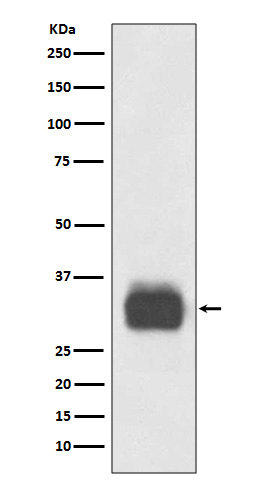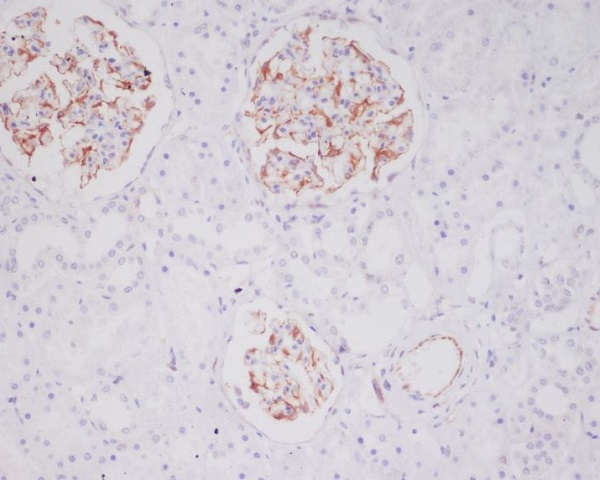



| WB | 1/1000-1/2000 | Human,Mouse,Rat |
| IF | 1/20-1/50 | Human,Mouse,Rat |
| IHC | 1/100-1/200 | Human,Mouse,Rat |
| ICC | 技术咨询 | Human,Mouse,Rat |
| FCM | 咨询技术 | Human,Mouse,Rat |
| Elisa | 咨询技术 | Human,Mouse,Rat |
| Aliases | TPS1; TPS2; TPSAB1; TPSB1; MCP 7 ; Mast cell protease 7; Tryptase alpha 1;;Tryptase 1 |
| WB Predicted band size | Calculated MW: 31 kDa ; Observed MW: 30 kDa |
| Host/Isotype | Rabbit IgG |
| Antibody Type | Primary antibody |
| Storage | Store at 4°C short term. Aliquot and store at -20°C long term. Avoid freeze/thaw cycles. |
| Species Reactivity | Human,Mouse,Rat |
| Immunogen | A synthesized peptide derived from human Tryptase 1 |
| Formulation | Purified antibody in PBS with 0.05% sodium azide,0.05% BSA and 50% glycerol. |
+ +
以下是3篇与肥大细胞类胰蛋白酶(Mast Cell Tryptase)抗体相关的代表性文献摘要:
1. **《Tryptase as a marker of mast cell activation in systemic anaphylaxis》**
作者:Schwartz LB et al.
摘要:验证肥大细胞类胰蛋白酶抗体在诊断系统性过敏反应中的特异性,证明其血清水平升高可作为肥大细胞活化的生物标志物。
2. **《Development of a monoclonal antibody specific for human mast cell tryptase》**
作者:Irani AM et al.
摘要:报道一种新型单克隆抗体的开发,该抗体可特异性识别人类肥大细胞类胰蛋白酶,用于组织切片中肥大细胞浸润的精准检测。
3. **《Tryptase measurement in mast cell disorders: Technical and clinical validation》**
作者:Valent P et al.
摘要:系统性评估类胰蛋白酶抗体在不同检测方法(ELISA/IHC)中的技术性能,及其在肥大细胞增生症诊断中的临床应用价值。
注:以上文献均为领域内经典研究,实际引用时建议通过PubMed/Google Scholar检索原文获取完整信息。如需实验抗体选择建议,可补充说明具体应用场景(如IHC/WB/流式)。
Mast cell tryptase is a serine protease predominantly stored in the secretory granules of mast cells, released during degranulation in allergic, inflammatory, or anaphylactic responses. It exists as a tetramer, primarily composed of β-tryptase isoforms (β1 and β2), with α-tryptase being a minor, less active form. Tryptase serves as a key mediator in immune responses, contributing to tissue remodeling, inflammation, and pathogen defense.
Antibodies targeting mast cell tryptase are critical tools for research and diagnostics. They enable the identification and quantification of tryptase in tissues or biological fluids, aiding in the diagnosis of mast cell-related disorders such as mastocytosis, systemic anaphylaxis, or chronic allergic conditions. In immunohistochemistry, these antibodies help localize mast cells in tissue samples, distinguishing normal from pathological mast cell activation. Elevated serum tryptase levels (>11.4 ng/mL) often indicate acute mast cell activation, making tryptase immunoassays essential in postmortem assessments of fatal anaphylaxis.
Additionally, tryptase antibodies are used to study mast cell biology, including their role in tumor microenvironments and fibrotic diseases. Monoclonal antibodies, like AA1 or G3. specifically detect β-tryptase, while others may target shared epitopes. Their specificity and sensitivity make them indispensable in both clinical settings and experimental research exploring mast cell pathophysiology.
×